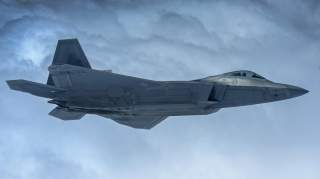War in the Sky: Russia's S-400 vs. America's Stealth F-35 and F-22 (Who Wins?)
We break it all down.
Typically, that resonance effect occurs when a feature on an aircraft—such as a tail-fin—is less than eight times the size of a particular frequency wavelength. Effectively, small stealth aircraft that do not have the size or weight allowances for two feet or more of radar absorbent material coatings on every surface are forced to make trades as to which frequency bands they are optimized for. That means that stealthy tactical fighters will show up on radars operating at a lower frequency bands—such as parts of the S or L band or even lower frequencies. Larger stealth aircraft such as the Northrop Grumman B-2 Spirit or forthcoming B-21 don’t have many of the airframe features that cause a resonance effect—and are, as such, much more effective against low-frequency radars.
Russian air defenses may appear formidable as part of Moscow’s increasingly sophisticated anti-access/area denial (A2/AD) capability, but areas protected by these systems are far from impenetrable bubbles or 'Iron Domes’ as some analysts have called them.
While it is true that a layered and integrated air defense may effectively render large swaths of airspace too costly—in terms of men and materiel—to attack using conventional fourth generation warplanes such as the Boeing F/A-18E/F Super Hornet or Lockheed Martin F-16 Fighting Falcon, these systems have an Achilles’ Heel. Russian air defenses will still struggle to effectively engage fifth-generation stealth aircraft such as the Lockheed Martin F-22 Raptor or F-35 Joint Strike Fighter.
“In terms of establishing viable air defenses against opponents with fifth generation aircraft, it's quite clear how Russia is trying to tackle the problem of stealth," said Mike Kofman, a research scientist specializing in Russian military affairs at CNA Corporation during an interview with The National Interest. “Russia's advanced radar, variety of capable missiles and systems that try to integrate large amounts of data for a more potent air defense will increasingly segregate Western air forces into two benches. In a future where these systems have proliferated to China, Iran and other regional powers there will be those that can penetrate and survive against advanced air defenses in a high end fight, and those whose job it is to bomb ISIL or its successor.”
(Note: This first appeared in 2016.)
Kofman notes that advanced Russian-built air defenses like the S-300, S-400 and forthcoming S-500 family come with systems designed to detect and track the presence of low observable (LO) aircraft such as the F-22 and F-35. That’s just a function of physics, as I have noted before. The problem for Moscow is that while Russian early warning and acquisitions radars operating in the VHF, UHF, L and S bands can detect and even track a tactical fighter-sized stealth aircraft, those systems don’t deliver a weapons quality track. “Russia has invested in low-band early warning radars, with some great variants out there, but can it use these to put a good picture together, and process it to develop a track against low-observation aircraft?” Kofman asked rhetorically.
Physics dictate that a tactical fighter-sized stealth aircraft must be optimized to defeat higher-frequency bands such the C, X and Ku bands, which are used by fire control radars to produce a high-resolution track. Industry, Air Force and Navy officials all agree that there is a “step change” in an LO aircraft’s signature once the frequency wavelength exceeds a certain threshold and causes a resonant effect—which generally occurs at the top part of the S-band.
Typically, that resonance effect occurs when a feature on an aircraft—such as a tail-fin—is less than eight times the size of a particular frequency wavelength. Effectively, small stealth aircraft that do not have the size or weight allowances for two feet or more of radar absorbent material coatings on every surface are forced to make trades as to which frequency bands they are optimized for. That means that stealthy tactical fighters will show up on radars operating at a lower frequency bands—such as parts of the S or L band or even lower frequencies. Larger stealth aircraft such as the Northrop Grumman B-2 Spirit or forthcoming B-21 don’t have many of the airframe features that cause a resonance effect—and are, as such, much more effective against low-frequency radars.
Recommended: How Israel Takes U.S. Weapons and Makes Them Better.
Recommended: North Korea’s Most Lethal Weapon Isn’t Nukes.
Recommended: 5 Worst Guns Ever Made.
For the Russians, solving the problem of targeting a low observable aircraft is something that they continue to work on—but it is doubtful the Moscow has resolved the issue. Russia's strong investment in layers of air defenses tells us that the Kremlin believes the primary threat to its ground forces comes from U.S. airpower. As such, defeating stealth technology is one of Moscow’s top priorities, Kofman notes, and the Kremlin has dedicated a lot of resources to that end.
Russia has tried a number of different techniques to defeat stealth technology. Among those is trying to develop a tight integrated air defense network with multiple radars trying to look at the same aircraft from different directions—but how effective those efforts have been is an open question. “It's great being able to see an aircraft, or parts of it, but getting accuracy such that you can confidently get a missile near the target is the primary challenge,” Kofman said.
While the Russians—and the Chinese—have not yet cracked the problem, it is clear that stealth is becoming much less of an advantage over time, though perhaps no less expensive an acquisition. Eventually, Moscow will find a solution to the stealth problem as the cyclical struggle between offense and defense continues ad infinitum—it’s just a matter of time.
Dave Majumdar is the defense editor for the National Interest. You can follow him on Twitter: @davemajumdar.


